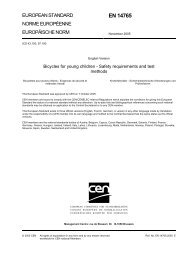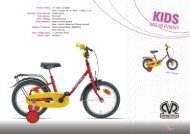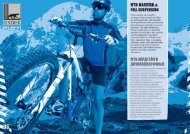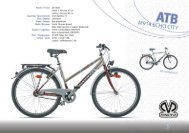EN 14766:2005 - 64_e_stf - Baltik vairas
EN 14766:2005 - 64_e_stf - Baltik vairas
EN 14766:2005 - 64_e_stf - Baltik vairas
- No tags were found...
Create successful ePaper yourself
Turn your PDF publications into a flip-book with our unique Google optimized e-Paper software.
<strong>EN</strong> <strong>14766</strong>:<strong>2005</strong> (E)4.10 Wheels and wheel/tyre assemblies4.10.1 Rotational accuracy4.10.1.1 GeneralRotational accuracy shall be as defined in ISO 1101 in terms of axial run-out tolerance (lateral). The run-outtolerances given in 4.10.1.2 and 4.10.1.3 represent the maximum variation of position of the rim (i.e. full indicatorreading) of a fully assembled and adjusted wheel during one complete revolution about the axle without axialmovement.For measurement of both axial run-out and radial run-out (concentricity) the wheel shall be fitted with a tyre inflatedto the maximum pressure as moulded on the tyre but, for rims where concentricity cannot be measured with thetyre fitted, it is permissible to make measurements with the tyre removed.4.10.1.2 Wheel/tyre assembly – concentricity toleranceFor wheels intended for rim-brakes, the run-out shall not exceed 1 mm when measured perpendicular to the axle ata suitable point along the rim (see Figure 38).For wheels not intended for rim-brakes, the run-out shall not exceed 2 mm.4.10.1.3 Wheel/tyre assembly – lateral toleranceFor wheels intended for rim-brakes, the run-out shall not exceed 1 mm when measured parallel to the axle at asuitable point along the rim (see Figure 38).For wheels not intended for rim-brakes, the run-out shall not exceed 2 mm.4.10.2 Wheel/tyre assembly – clearanceAlignment of the wheel/tyre assembly in a bicycle shall allow not less than 6 mm clearance between the tyre andany frame or fork element or a mudguard and its attachment bolts.Where an off-road bicycle has a frame or a fork with a suspension system the clearances shall be measured withthe appropriate suspension system compressed to the limit specified by the manufacturer (see also 4.9.3).4.10.3 Wheel/tyre assembly – static strength test4.10.3.1 RequirementWhen a fully assembled wheel fitted with a tyre inflated to the maximum pressure as permanently marked on thetyre is tested by the method described in 4.10.3.2, there shall be no failure of any of the components of the wheel,and the permanent set, measured at the point of application of the force on the rim, shall not exceed 1 mm.4.10.3.2 Test methodClamp and support the wheel suitably as shown in Figure 39 and apply a static force of 370 N at one point on therim, perpendicular to the plane of the wheel. Apply the force once only for a duration of 1 min.In the case of a rear wheel apply the force from the sprocket side of the wheel as shown in Figure 39.62







